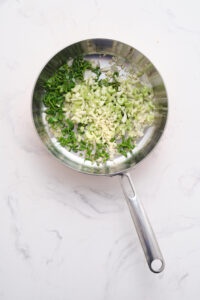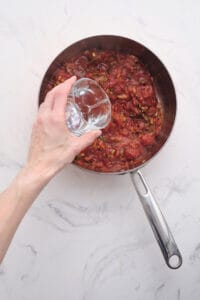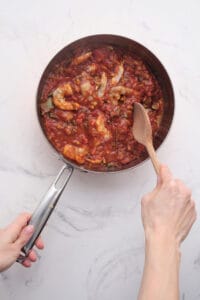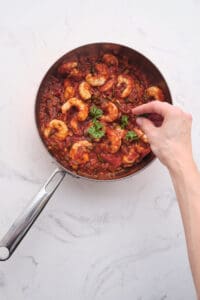Your guests will be going back for seconds of this smoldering, seasoned seafood feast!

New Orleans has been my home for the past year, and Creole food has become a staple in my diet. Creole sauces, Creole-spiced meats, Creole eggs; hell, I even ate Creole-Chinese fusion food the other night. Also ubiquitous in New Orleans is shrimp, and a hefty percentage of the shrimp I eat every week is cooked Creole-style.
As a mix of African, French and Spanish influences, shrimp Creole is thick, tomatoey and filled with succulent seafood and a whole pantry of spices, herbs and vegetables.
I was told when I first moved to the Marigny neighborhood that, “New Orleanians don’t like spicy, but they do love flavor.” Shrimp Creole is emblematic of that statement; rich and full-bodied, with a whole smörgåsbord of flavors that dance around your mouth.
There’s nothing too spicy here, but if you swing that way, keep a bottle of Louisiana Hot Sauce on the table and you’ll be good to go. Pour this delicious seafood concoction over a bed of freshly steamed white rice, and you just might be able to hear sweet jazz playing in the background like you’re dining in the steamy French Quarter.
Is Shrimp Creole Healthy?
With all the beignets and fried chicken flowing down Bourbon Street, you just landed a diet dream with this shrimp Creole recipe, as it’s one of the few relatively healthy dishes served in New Orleans.
Shrimp is a high-protein, low-calorie food that’s packed with antioxidants and iodine, but be aware that shrimp is also high in cholesterol, so it’s not suited to every diet out there.
What is Creole Food?
Creole is the ethnic group descended from people who lived in colonial Louisiana before US statehood, when the French and Spanish were in charge. Creole is not a racial label; Africans, Europeans and people of mixed ancestry can claim Creole heritage.
The label grew to include Native Americans, people of the Caribbean and Germans, which in turn, greatly opened up the types of food served, but “Creole” as a label traditionally has stronger ties to French and Spanish colonial legacies.
Basically, Creole cuisine draws from a variety of influences, including African, Spanish and Native American traditions, and uses French cooking methods to prepare the ingredients. Characteristics include complex flavor combinations, a diverse array of ingredients and heavy usage of seasonings.
INGREDIENTS
- 2 tablespoons olive oil
- 1/2 large onion, chopped
- 1 green bell pepper, chopped
- 2 celery stalks, chopped
- 4 garlic cloves, minced
- 1 can (14.5 ounces) diced tomatoes, undrained
- 1/2 cup spicy tomato sauce
- 2 teaspoons Worcestershire sauce
- 2 bay leaves
- 1 tablespoon Creole seasoning
- Cayenne pepper to taste
- Salt and black pepper to taste
- 1 pound large shrimp, peeled and deveined
- Freshly chopped parsley, for garnish
- Cooked long-grain rice, for serving

INSTRUCTIONS
Sauté
Cook vegetables until tender.
Simmer
Combine sauce ingredients and simmer.
Finish
Add shrimp and cook until done. Serve hot over rice, with fresh parsley on top.
Devour!

FAQs & Tips
Make it the night before (without the shrimp) and store in the refrigerator so that all those Creole seasonings can get to mingle. Reheat the sauce slowly before adding the shrimp. If you don’t want to do that, let the whole pot of stew (with shrimp) simmer for at least an hour. Leftovers will stay delicious in the refrigerator for 2 to 3 days.
Shrimp is a highly popular food, and the United States imports up to 90% of its shrimp, primarily from countries such as India, Indonesia, Vietnam, and Thailand. In some of these countries, antibiotics are used in shrimp farming to prevent diseases in crowded farming pools. Although no direct adverse health effects from eating farmed shrimp have been conclusively confirmed, there are potential risks, such as contributing to antibiotic resistance or triggering allergic reactions. To minimize these risks, consider buying wild-caught shrimp or shrimp from sources certified to avoid antibiotic use, such as those with Aquaculture Stewardship Council (ASC) or similar certifications.
A lot of shrimp are sold de-veined, de-shelled and de-headed, but diehards swear that cooking with the whole shrimp results in a more delicious shrimp dish. Cooking with the shell on protects the shrimp and keeps it tender. Shrimp enthusiasts often say that the shrimp head is the tastiest, most nutritious part, and that eating the shell adds another dimension of texture. While this does save you the problem of peeling your shrimp over your shrimp Creole at the dinner table, do whatever you prefer.

Serving Suggestions
Classic shrimp Creole is served over a bed of steaming White Rice. You will also want some crusty Garlic Bread to sop up the mouth-watering sauce. No matter what Southern dish you are cooking, Cornbread is a must.
Some vegetable side dishes will counteract the richness of the main course; Okra, Green Beans, and Corn are all Southern staples.


Shrimp Creole
Ingredients
- 2 tablespoons olive oil
- 1/2 large onion chopped
- 1 green bell pepper chopped
- 2 celery stalks chopped
- 4 garlic cloves minced
- 1 can (14 1/2 ounces) diced tomatoes undrained
- 1/2 cup spicy tomato sauce
- 2 teaspoons Worcestershire sauce
- 2 bay leaves
- 1 tablespoon Creole seasoning
- Cayenne pepper to taste
- Salt to taste
- Ground black pepper to taste
- 1 pound large shrimp peeled and deveined
- Long grain rice cooked, for serving
- Fresh parsley chopped, for garnish
Instructions
-
Heat olive oil in a large skillet over medium heat. Add chopped onion, green bell pepper, celery, and garlic. Cook until the vegetables are tender, about 5 to 7 minutes.

-
Add diced tomatoes with their juice, tomato sauce, Worcestershire sauce, Creole seasoning, and bay leaves. Season with salt, black pepper, and cayenne.
-
Bring to a simmer and cook uncovered for 20 minutes, allowing flavors to meld. Add some water if the mixture becomes too thick. Adjust seasonings as needed.

-
Add the shrimp to the skillet and cook until they are pink and opaque, about 3 to 6 minutes. Remove the bay leaves.

-
Serve hot over rice. Sprinkle with fresh parsley for garnish.

Nutrition
The post Shrimp Creole appeared first on Food Faith Fitness.






